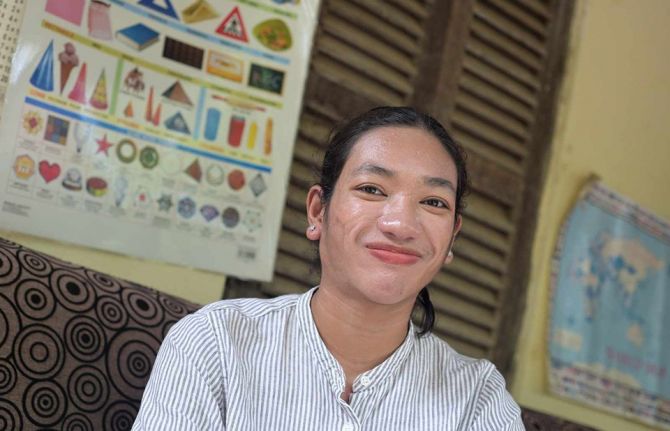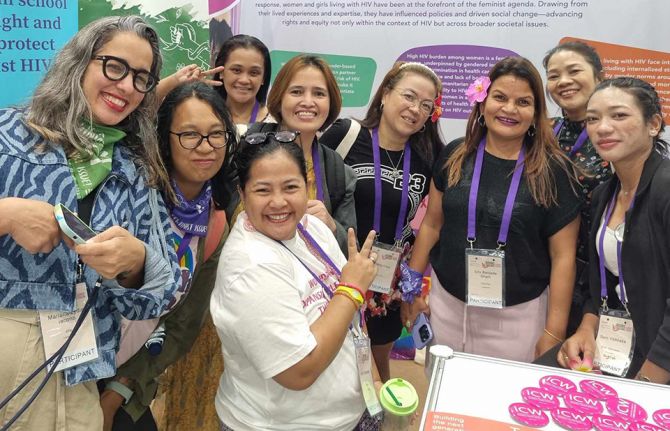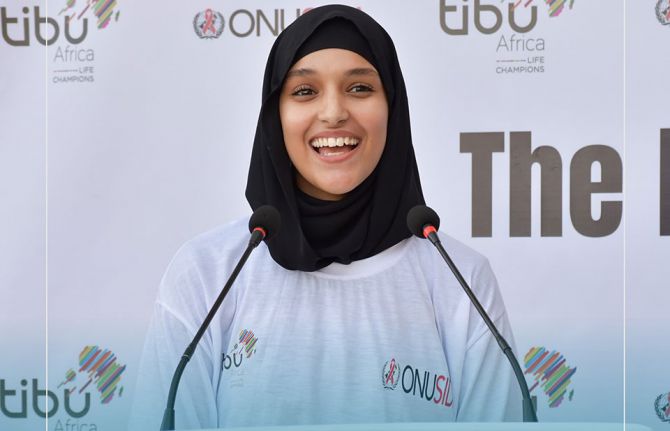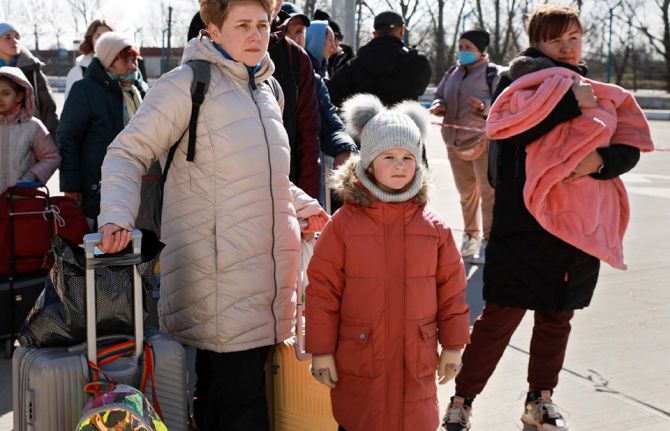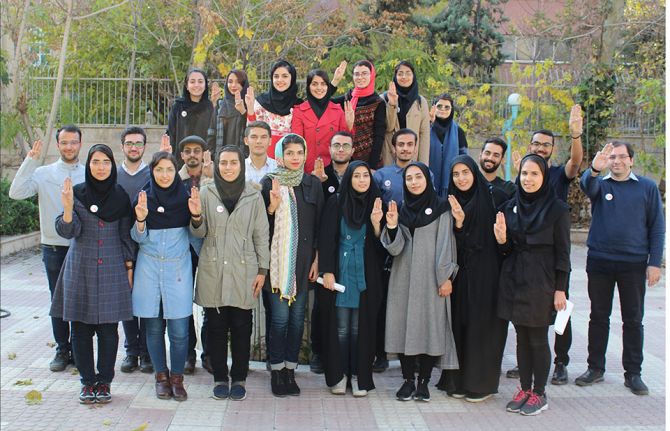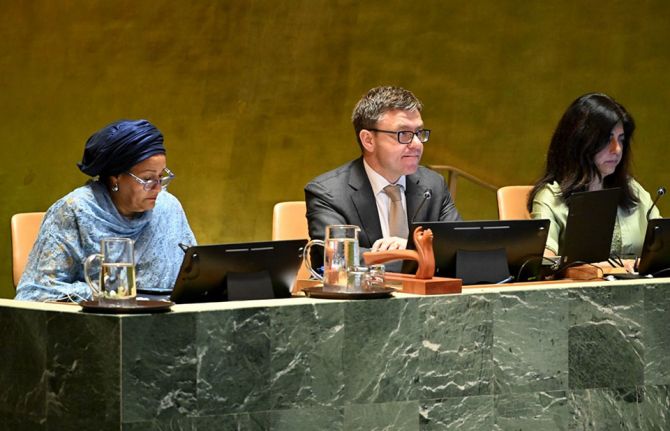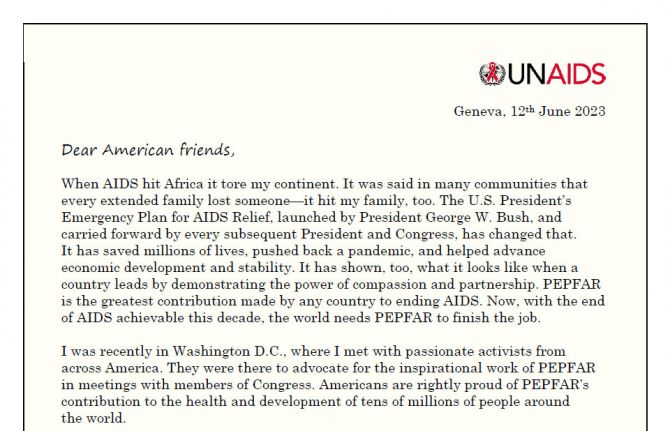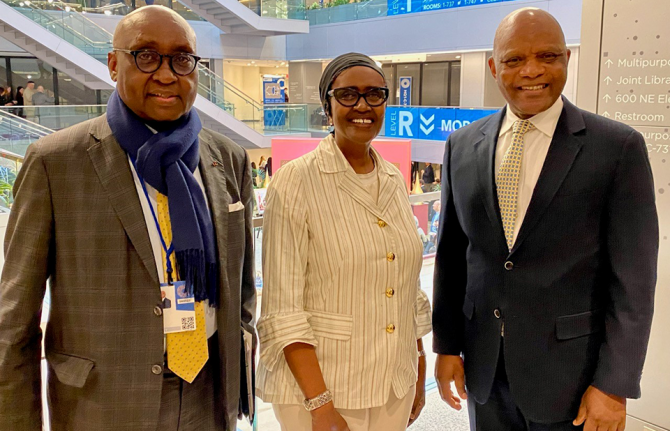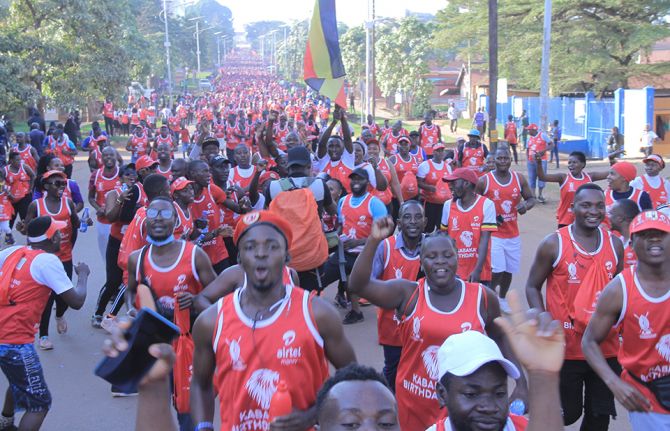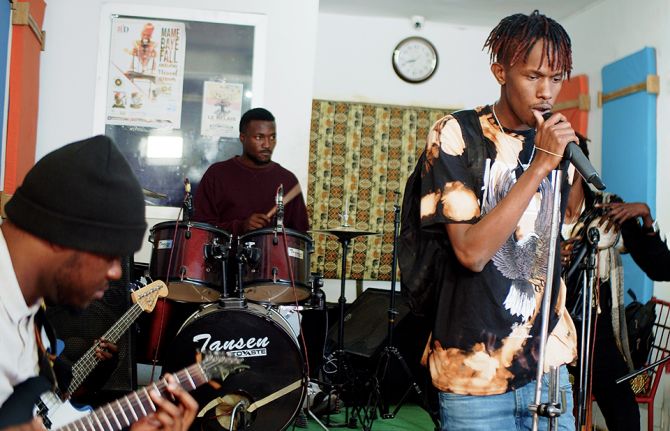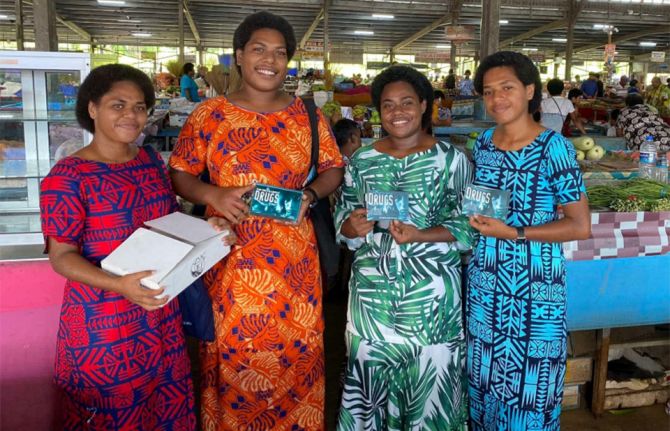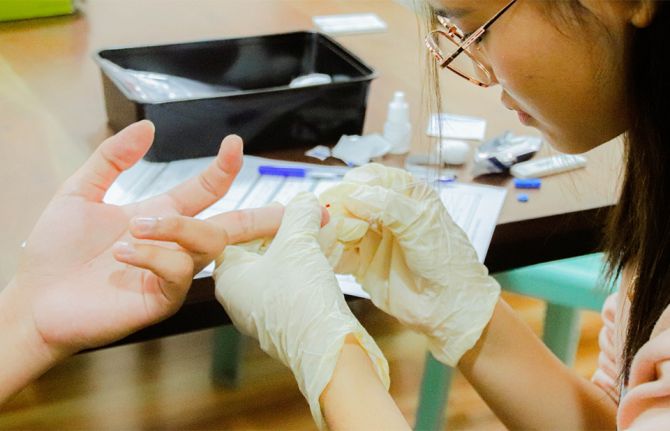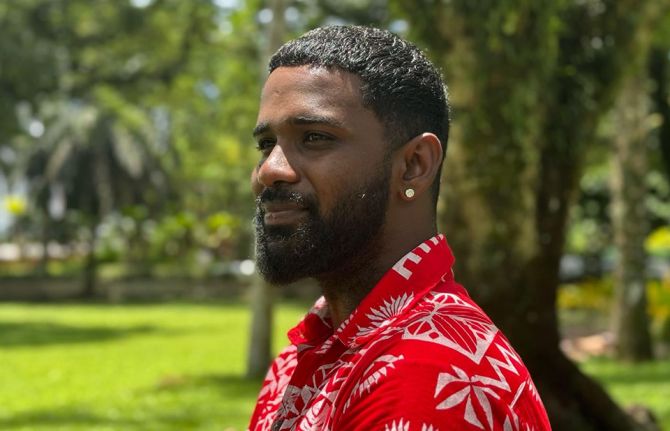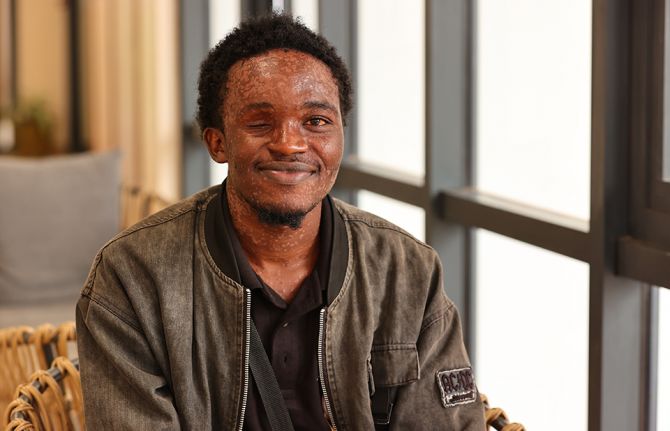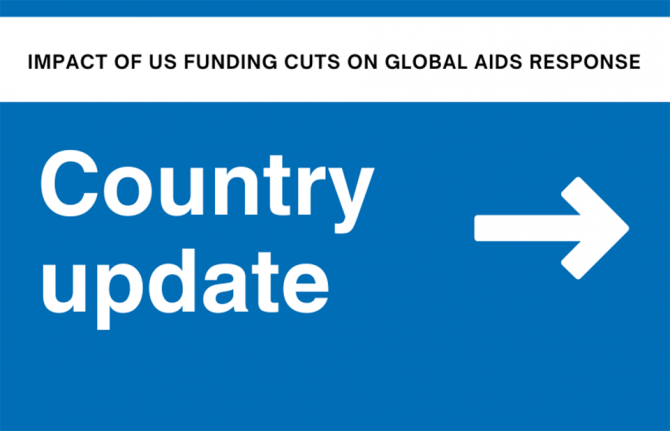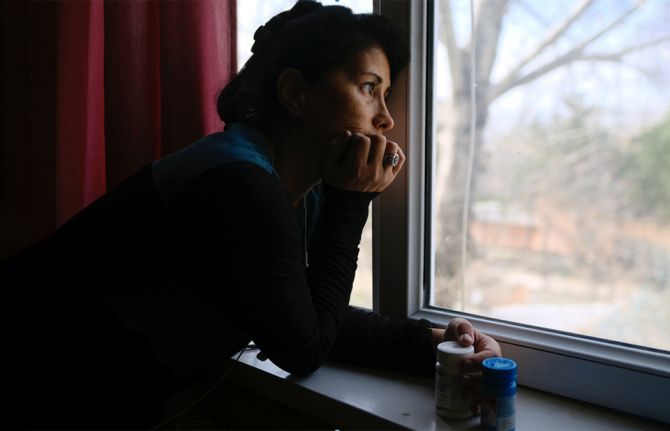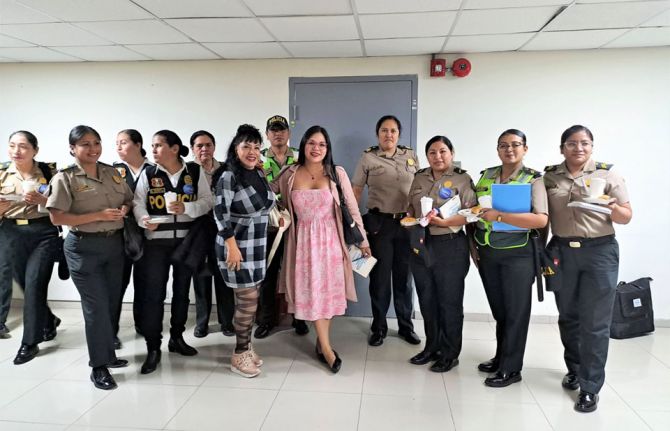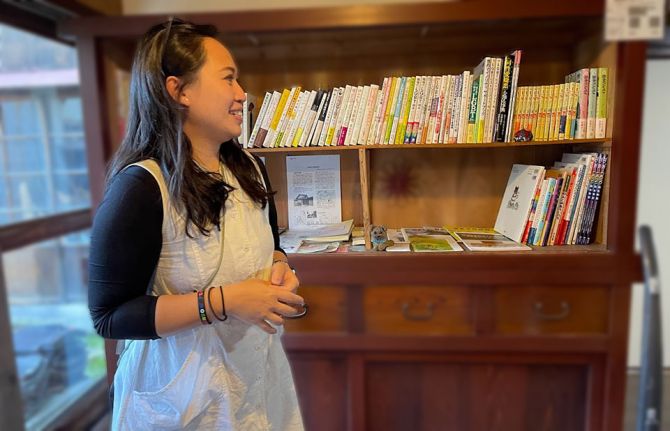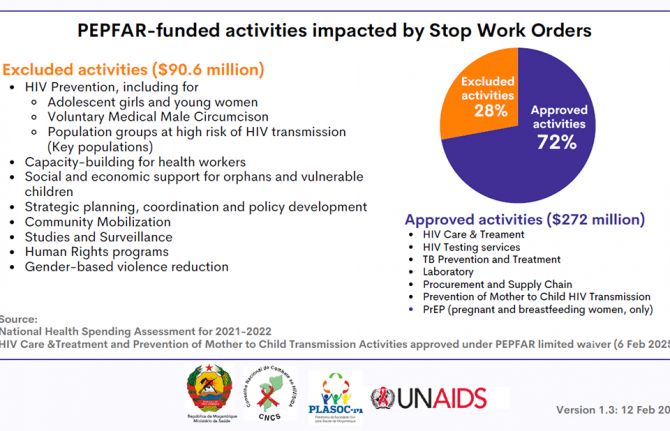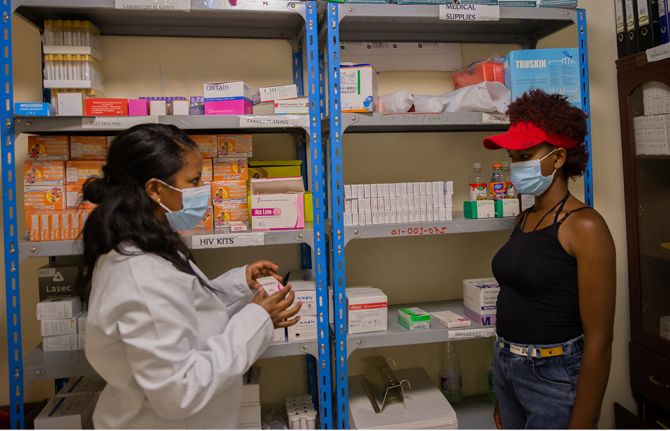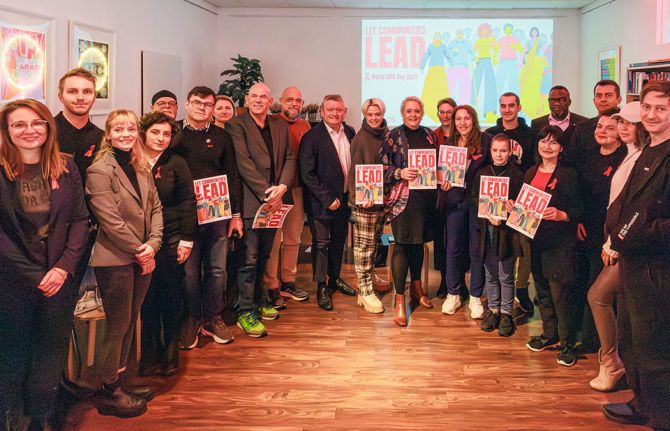
Feature Story
Meeting the needs of women living with HIV in Washington DC
19 September 2011
19 September 2011 19 September 2011
UNAIDS Executive Director Michel Sidibé met with nearly 30 women living with HIV during his visit to Women’s Collective, a non-profit organization that provides HIV services for women and their families. 16 September 2011.
Credit: UNAIDS/ B.Smialowski
During an official visit to Washington DC, UNAIDS Executive Director Michel Sidibé made a special stop at the Women’s Collective, a non-profit organization that provides HIV prevention, testing, care and support for women and their families in some of D.C.’s most underserved communities.
The Women’s Collective is run by women living with HIV and provides a safe, non-judgmental environment for women, girls and their families who are living with or at risk of HIV. Its objective is to meet the needs of women living with HIV by reducing barriers to care and strengthening their network of support. Their activities include organizing support groups, HIV testing, HIV prevention education, case management and referrals.
Founder and Executive Director of the Women’s Collective, Patricia Nalls led the visit and described the impact that the epidemic was having among women in the District of Columbia. According to most recent epidemiological data, at least 3 percent of the residents in this District are living with HIV.
She explained how women’s clinical and social services don’t really fit into the current framework of services, which are usually focused on men. Women have families, children, and often worry first about providing for them than taking care of themselves. They worry not only about disclosure, but about co-payments for medicine, housing, employment, and of course, their children.
During the visit, Mr Sidibé met with nearly 30 women living with HIV to discuss some of the challenges they face in their every day lives and how the Women’s Collective is making a difference for them and their families.
“So often the global response gets all the attention, but we are part of the globe,” said one of the members. “People think that here in the United States we have all the services that we need. That is clearly not true.”
Michel Sidibé expressed that he was he was touched by the women’s collective strength and leadership and emphasized UNAIDS’ commitment to place women at the center of the global AIDS response.
External links
External links

Feature Story
Uniting around a common agenda to address HIV and non-communicable diseases
19 September 2011
19 September 2011 19 September 2011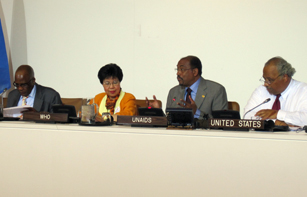
L to R: South African Minister of Health Dr Aaron Motsoaledi, Director-General of WHO Dr Margaret Chan, UNAIDS Executive Director Michel Sidibé and US Global AIDS Coordinator Eric Goosby participating in the UNAIDS and WHO event on NCDs and HIV.
At the United Nations High Level Meeting on AIDS in New York this June Heads of State and Government adopted a new Political Declaration on HIV/AIDS. As well as setting bold targets to scale-up the response to HIV by 2015, the declaration also included a commitment to work with partners to strengthen advocacy, policy and programmatic links between HIV and non-communicable diseases (NCDs).
On 19 - 20 September 2011, Heads of State and Government are coming together at the United Nations in New York, this time to address the prevention and control of NCDs worldwide. The High Level Meeting of the United Nations General Assembly on the Prevention and Control of NCDs will provide unique opportunity for both NCD and HIV communities to work together for a common agenda.
"Maximizing synergies and integration has been a central focus for UNAIDS for many years,” said UNAIDS Executive Director Michel Sidibé. “AIDS is not an isolated disease, it is a movement which can be leveraged to benefit a wide range of health and development issues.”
AIDS is not an isolated disease, it is a movement which can be leveraged to benefit a wide range of health and development issues
UNAIDS Executive Director Michel Sidibé
Non-communicable diseases––in particular cardiovascular diseases, cancers, chronic respiratory diseases and diabetes––are the biggest cause of death worldwide. More than 36 million people die annually from NCDs (63% of global deaths), including 9 million people who die too young, before the age of 60. More than 90% of these premature deaths from NCDs occur in developing countries and could have largely been prevented.
Experience in addressing HIV and NCDs shows that many of the challenges are common; organizing and delivering adequate prevention services; chronic treatment and care; addressing the social and environmental determinants of these health issues; and reaching people without access to services and people who are disproportionally affected by these diseases both particularly common in regions such as Sab-Saharan Africa.
During the High Level Meeting, UNAIDS and WHO will co-host an event on Tuesday 20 September to unite participants around a common agenda to address NCDs and HIV. The panel will include the Director-General of WHO, the Executive Director of UNAIDS, the South African Minister of Health, the US Global AIDS Coordinator, WHO’s Goodwill Ambassador for Cancer Control and a representative from civil society.
Participants will discuss lessons learnt from experience in responding to NCD’s and HIV. They will also look at finding ways to scale-up action to broadly integrate HIV and NCD programmes, improve health systems and ensure that people most in need have access to services.
External links
External links
Multimedia
Publications
Publications
- Uniting to address NCDs and HIV (event flyer)
Related

Feature Story
United States Congress launches new bi-partisan caucus to strengthen the US’s response to AIDS
15 September 2011
15 September 2011 15 September 2011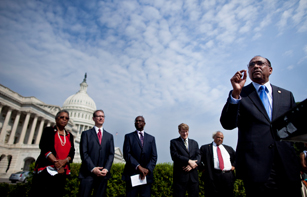
UNAIDS Executive Director Michel Sidibe speaking at the launch of the Congressional HIV/AIDS Caucus on Capitol Hill, Washington, DC. 15 September 2011.
The United States Congress has launched a new bi-partisan caucus to strengthen the US’s response to AIDS both at home and around the world and maintain its position as a global leader on AIDS. The launch of the bipartisan Congressional HIV/AIDS Caucus was announced at an event in Washington DC by the three Caucus co-chairs; Congresswoman Barbara Lee; Congressman Trent Franks and Congressman Jim McDermott.
The co-chairs were joined, among others, by the Executive Director of UNAIDS, Michel Sidibé, who commended the US on its continued commitment to HIV. "The United States' global leadership and the generosity of the American people have made a profound and positive difference in the AIDS epidemic. This sustained commitment, across political administrations for more than a decade, has saved millions of lives. And I am counting on the Congressional HIV/AIDS Caucus to continue to play a critical role in shaping the future of the AIDS response."
The United States has played a leading role in the global responding to HIV and its commitment is the largest by any country for a single disease. In 2003 President George W. Bush launched the U.S. President’s Emergency Plan for AIDS Relief (PEPFAR) which now has partnerships in 30 countries worldwide and has committed nearly US$ 39 billion to HIV and TB since its inception.
The United States' global leadership and the generosity of the American people have made a profound and positive difference in the AIDS epidemic
UNAIDS Executive Director Michel Sidibé
In 2010, PEPFAR estimates that its funding and programmes directly supported life-saving antiretroviral treatment for more than 3.2 million men, women and children worldwide.
“We cannot fool ourselves into thinking that we have HIV under control, because we don’t,” said Congressman Jim McDermott, Co-Chair of the Congressional HIV/AIDS Caucus. “Despite the enormous progress we have made over 30 years, we still have no vaccine, and treatment remains out of reach for so many. We have to keep our eye on the ball and continue pushing forward: prevention, treatment, and finding a vaccine must remain our focus.”
The caucus currently has around 60 members and will focus its work on some key thematic areas; sustaining U.S. leadership and funding for HIV; promoting scientific advances; strengthening U.S. domestic programs and expanding the role of faith-based organizations. It will also provide opportunities to galvanize new leadership in preparation for the International AIDS Conference to be held in Washington, D.C. in July 2012.
U.S. Global AIDS Ambassador Eric Goosby, Jeff Crowley of the White House Office of National AIDS Policy, Michael Gerson from the Washington Post, and a number of advocates from the faith community and the U.S. domestic AIDS advocacy community also participated in the launch.
Related

Press Release
UNAIDS and Xinhua announce a new global media campaign on HIV
15 September 2011 15 September 2011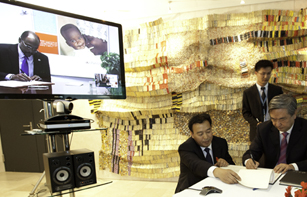
President of Xinhua News Agency Li Congjun and UNAIDS Executive Director Michel Sidibé signing a Memorandum of Understanding of Strategic Cooperation between Xinhua and UNAIDS. 15 September 2011. Geneva.
Credit: UNAIDS
GENEVA, 15 September 2011—The Joint United Nations Programme on HIV/AIDS (UNAIDS) and Xinhua, China’s all-media news group, announced Thursday a plan to launch a media campaign globally on World AIDS Day 2011.
This cooperation is part of the two institutions’ new strategic partnership, which aims to raise public awareness of the HIV epidemic.
Li Congjun, the President of Xinhua News Agency and Michel Sidibé, Executive Director of UNAIDS participated in a signing ceremony of a Memorandum of Understanding (MOU) of Strategic Cooperation between Xinhua and UNAIDS.
Mr. Li signed the MOU during a visit to UNAIDS’ headquarters in Geneva, while Mr. Sidibé joined in the ceremony through a video conference from Washington DC.
Both organizations will leverage their expertise to reach universal access goals towards HIV prevention, treatment, care and support. UNAIDS will provide its knowledge concerning the epidemic in China and worldwide, while Xinhua will mobilize its all-media service around the world to promote HIV issues and call for support from countries, civil society, businesses and other key players in the AIDS movement.
Xinhua is China’s most influential news institution with over 30 domestic branches and 150 branches outside of China.
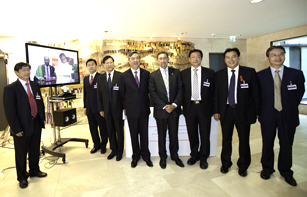
Group picture of the Xinhua News Agency delegation with UNAIDS Deputy Executive Director Dr Paul De Lay (center) and UNAIDS Executive Director Michel Sidibé (on screen).
Credit: UNAIDS
Mr. Li, who is in Geneva as part of an European working tour said, “The MOU lays a solid foundation for Xinhua and UNAIDS’ long term cooperation. The World AIDS Day 2011 news campaign is a great starting point for this strategic partnership.”
Mr. Sidibé said, “I welcome this new partnership with Xinhua which combines the power of Xinhua’s extensive global media presence with UNAIDS’ in-depth knowledge of the AIDS epidemic worldwide to promote a revitalized AIDS movement. Together we can reach Zero new HIV infections, Zero discrimination and Zero AIDS-related deaths.”
UNAIDS’ vision of “Getting to Zero” has been chosen as the main theme for World AIDS’ Day during the next five years. Millions of people around the globe mark World AIDS day on December 1 by commemorating the lives lost to AIDS and recommitting to the AIDS response.
The New MOU between UNAIDS and Xinhua is for an initial period of two years, ending in September 2013.
Xinhua has formed partnerships on important development projects with several UN agencies, including the United Nations Children’s Fund (UNICEF), the United Nations Educational, Scientific and Cultural Organization (UNESCO), United Nations Environment Programme (UNEP), United Nations Development Programme (UNDP) and the United Nations Framework Convention on Climate Change (UNFCCC) Secretariat.
Last year the news organization worked with one of UNAIDS’ Co-Sponsors, WFP on a special report to coincide with World Food Day. Earlier this year, Xinhua worked on an photo exhibition with another UNAIDS’ Co-Sponsor, UNESCO.
Press centre
Download the printable version (PDF)

Feature Story
7 billion people - 7 Billion Actions
14 September 2011
14 September 2011 14 September 2011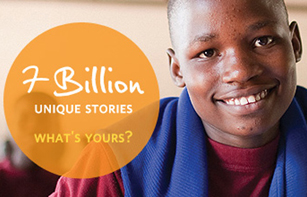
The 7 Billion Actions campaign is intended to act as a rallying point for collective action to improve life for present and future generations.
By the end of this year there will be 7 billion people on the planet. To mark this global milestone, which represents both significant opportunities and challenges, the United Nations Population Fund (UNFPA) and its partners have launched an innovative campaign.
Called 7 Billion Actions, the platform is designed to promote a healthy and sustainable world. It brings together a wide range of UN bodies, including UNAIDS, governments, businesses, NGOs, academics, media practitioners, grass roots organizations and individuals. The campaign, according to UNFPA, will act as a rallying point for collective action to improve life for present and future generations.
According to UNFPA Executive Director Dr Babatunde Osotimehin the campaign aims to realize untapped potential, “It is about embracing the dignity and human rights of every individual. We need to create conditions for each one of us to live on a healthy planet, so we can all reach our full potential. In a world of 7 billion people, we need to count on each other.”
We need to create conditions for each one of us to live on a healthy planet, so we can all reach our full potential. In a world of 7 billion people, we need to count on each other
UNFPA Executive Director Dr Babatunde Osotimehin
On September 14 the UN Secretary-General, Ban Ki-moon, will host an interactive discussion for its official launch. The event will be live streamed and participants from around the world can be part of the global conversation through questions and comments. The campaign’s key launch activities will take place in September and October, culminating in 7 Billion Day on 31 October.
There are a number of thematic areas that the 7 Billion Actions will address. These include: breaking the cycle of poverty and inequality; promoting the empowerment of women and young people and reproductive health and rights; and focusing on the environment, ageing populations and urbanization.
“This inspirational campaign connects people, ideas and actions. UNAIDS looks forward to joining the effort to ensure all voices are heard as we reach this important milestone,” said UNAIDS Executive Director Michel Sidibé.
The challenge to HIV is a critical component of several themes. Greater empowerment of women and girls will have an impact on the AIDS epidemic. For example, many women are subjected to gender-based violence and this may severely hamper their ability to protect themselves against HIV. In the area of the right to an education; increasing girls’ access to schooling has been seen as a ‘social vaccine’ against the virus.
Dealing with HIV and maternal and reproductive health and rights in an integrated way also makes for stronger and more effective service provision. Where HIV testing, eliminating new HIV infections among children, access to condoms, contraception and correct information are all ‘under one roof’ women are more likely to stay healthy. AIDS is still the leading cause of death and disease among women of child-bearing age in low- and middle-income countries.
How to support the initiative
In practical terms, support for the initiative can be shown in a number of ways. For instance, its main messages can be integrated into partners’ programme development; a commitment to the platform championed in statements and public appearances; financial contributions made on individual and corporate levels, and projects, work and best practices shared using the 7 Billion Actions online tools, such as the global website, Twitter and Facebook.
According to the campaign, it is possible to not only build on the work of UN bodies, companies and NGOs, but also on the efforts of individuals: in a world of 7 billion people, incremental actions can create exponential results.
For more information on how to become part of the campaign visit:
www.7billionactions.org
External links
External links

Feature Story
Recognizing the needs of female injecting drug users in north-east India
13 September 2011
13 September 2011 13 September 2011A version of this story was first published at unodc.org

Across north-east India, women affected by drug use are finding safe spaces dedicated to their particular needs.
Twenty-two year old Chawngmawii from Mizoram state in north-east India left home when she was 16. Having suffered abuse while growing up, she started living on the streets and injecting drugs. She turned to sex work to support her drug habit and was diagnosed with HIV in 2008.
With the help of a local organization, Chawngmawii went to a centre that works with people who use drugs, one of a number set up by the state and supported by the National AIDS Control Programme. However, she says she felt unwelcome because the centre was mostly geared towards male clients.
Chawngmawii's story is similar to what many women face in north-east India. Despite the availability of free services for people who use drugs through both government hospitals and non-governmental organizations, a significant proportion of women have reported they haven’t been able to access treatment for HIV. The lack of trained female service providers often deters women from seeking help, and the existing drop-in centres are primarily used by men.
The United Nations Office on Drugs and Crime (UNODC), with the support of Australia’s AusAID and UNAIDS, is working with the Government of India to improve the quality and coverage of services for drug treatment. Injecting drug use is the principal cause of the HIV epidemic in the north-east and around 25% of the people who inject drugs and live in this region. Under a joint United Nations programme, UNODC works in the four states of Manipur, Nagaland, Mizoram and Meghalaya, focusing particularly on establishing HIV-prevention services for women.
The majority of the staff involved in the initiative are women, providing a comfortable environment for female drug users seeking help. The project also addresses more gender-specific requirements such as pre- and post-natal care and parenting support. There is also access to antiretroviral therapy, treatment for sexually transmitted infections and drug treatment services, including opioid substitution therapy.
Drug use in the north-east is a pressing issue and widening support is a crucial and welcome development
UNAIDS Country Coordinator for India, Dr Charles Gilks
Chawngmawii enrolled at the female drop-in centre in Aizawl, Mizoram, and has been visiting the centre every day since October 2010. "I go and rest, have a bath and eat, something which I could never do in the other centres, as there were too many men. It is a safe haven and I really feel at home." With a female doctor at the centre, Chawngmawii can get regular health checks and free medication.
The most striking outcome of the initiative has been its easy acceptance among women who use drugs. Within six months, the programme has become well established, mirroring the experience with similar UNODC projects in Bangladesh and Nepal. As of June this year, the project has reached 242 women and 606 female partners of male drug users in the four sites.
Dr Charles Gilks, the UNAIDS Country Coordinator for India, says the project is a timely and much needed activity. "I was really impressed by the innovative work by the team there. The women I met really seemed to respond to being in a setting that deals with their specific concerns and gave them some protected space. Drug use in the north-east is a pressing issue and widening support is a crucial and welcome development.”
External links
External links

Press Release
The George W. Bush Institute, the U.S. Department of State, Susan G. Komen for the Cure®, and UNAIDS announce new women’s health initiative
14 September 2011 14 September 2011Pink Ribbon Red ribbon partnership expands critically needed breast and cervical cancer interventions in sub-Saharan Africa

President George W. Bush together with UNAIDS Executive Director Michel Sidibé at the launch of the Pink Ribbon Red Ribbon initiative.
Credit: Bush Center
WASHINGTON, D.C., 13 September 2011—The George W. Bush Institute, the U.S. Department of State, the U.S. President’s Emergency Plan for AIDS Relief (PEPFAR), Susan G. Komen for the Cure®, and the Joint United Nations Programme on HIV/AIDS (UNAIDS) will today announce Pink Ribbon Red Ribbon®, an innovative partnership to leverage public and private investment in global health to combat cervical and breast cancer — two of the leading causes of cancer death in women - in Sub-Saharan Africa and Latin America. Pink Ribbon Red Ribbon will expand the availability of vital cervical cancer screening and treatment and breast care education—especially for women most at risk of getting cervical cancer in developing nations because they are HIV-positive.
"It’s time to take the next step in building on the progress that has been made over the past decade in the fight against HIV and AIDS,” said President George W. Bush. “Many women who seek AIDS services also face the challenge of cancer. It’s not enough to save a woman from AIDS, if she is then left to die of another very preventable disease."
The cervical cancer partnership will leverage the platform and resources of PEPFAR — established under President Bush and a cornerstone of President Obama’s Global Health Initiative (GHI) — and will draw from lessons learned in the significant scaling-up of access to HIV interventions in recent years. As breast cancer has not been linked to HIV, PEPFAR funds will not be used for direct support of breast cancer activities. However, other Pink Ribbon Red Ribbon partners will leverage the PEPFAR platforms, using other sources of funding, to support breast cancer efforts.
“Investing in women’s health is the right thing to do and the smart thing to do. Pink Ribbon Red Ribbon will save women’s lives and in turn help families and whole communities. Through this new partnership, the U.S. Government has committed an additional $10 million, which brings our total PEPFAR investment to $30 million over the next five years. Under the leadership of Secretary Clinton and U.S. Global AIDS Coordinator Ambassador Eric Goosby, the State Department is proud to join this important and ambitious partnership to address breast and cervical cancer globally,” said Ambassador Melanne Verveer, Ambassador-at-Large Global Women's Issues.
Women whose immune systems are compromised by HIV are more likely to develop cervical cancer. Through PEPFAR, there is already screening and treatment of women at more than 250 clinics in 11 African countries. Through PRRR PEPFAR has committed an additional $10 million, which will bring the total PEPFAR investment to $30 million over the next five years and ensure more women will be able to be screened and saved.
“Today the majority of women in Sub-Saharan Africa do not have access to critical breast and cervical cancer screening and treatment services and we must move quickly to address this growing epidemic,” said Ambassador Nancy G. Brinker, founder and CEO of Susan G. Komen for the Cure. “The PRRR partnership builds on our long-standing efforts in Africa and globally to support innovative models that will save lives by detecting breast and cervical cancer earlier, when there is still time to treat it.”
With initial indications of interest, PRRR expects to have commitments of up to $75 million across 5 years, which will grow to include additional participants and services. The goals are to reduce deaths from cervical cancer by an estimated 25% among women screened and treated through the initiative, significantly increase access to breast and cervical cancer prevention, screening and treatment programs, and create innovative models that can be scaled up and used globally.
This public-private initiative includes initial commitments from founding corporate participants Merck, Becton Dickinson, QIAGEN, Caris Foundation, Bristol-Myers Squibb, GlaxoSmithKline and IBM.
“The rapid expansion of HIV prevention and treatment services over the past decade has saved millions of lives,” said Michel Sidibé, Executive Director of UNAIDS. “Uniting the efforts of two vital health movements means more women around the world will be reached with integrated—not isolated care.”
Infection with HIV weakens the immune system and reduces the body’s ability to fight infections that may lead to cervical cancer. Cervical cancer is 4-5 times more common among women living with HIV than women who are HIV-negative.
There is an urgent need to develop innovative and sustainable solutions to addressing women’s cancers in developing nations, where these diseases are often neglected and associated with stigmas that discourage women from accessing life-saving prevention, care and treatment programs. By leveraging the significant investments made in HIV prevention, care and treatment, it is possible to integrate simple, cost-effective preventions, screening and testing methods and dramatically reduce mortality and late-stage diagnosis of cervical cancer, while continuing to increase access to breast care education.
UNAIDS
UNAIDS, the Joint United Nations Programme on HIV/AIDS, is an innovative United Nations partnership that leads and inspires the world in achieving universal access to HIV prevention, treatment, care and support. Learn more at unaids.org.
George W. Bush Institute
The George W. Bush Institute seeks to improve the human condition through human freedom, educational reform, global health, and economic growth. In all its programming, the Institute integrates initiatives that empower women and support social enterprise as proven catalysts for change. The Bush Institute is the innovation policy arm of the George W. Bush Presidential Center, which promotes the Presidential library, located on the campus of SMU in Dallas. For more information, please visit www.bushcenter.com.
PEPFAR
The U.S. President’s Emergency Plan for AIDS Relief (PEPFAR) is the U.S. Government initiative to save the lives of those affected by HIV/AIDS around the world. This historic commitment is the largest by any nation to combat a single disease internationally, and PEPFAR investments also help alleviate suffering from other diseases across the global health spectrum. PEPFAR is driven by a shared responsibility among donor and partner nations and others to make smart investments to save lives. For more information about PEPFAR, visit www.PEPFAR.gov, http://twitter.com/uspepfar, or www.facebook.com/PEPFAR.
Susan G. Komen for the Cure
Nancy G. Brinker promised her dying sister, Susan G. Komen, she would do everything in her power to end breast cancer forever. In 1982, that promise became Susan G. Komen for the Cure and launched the global breast cancer movement. Today, Komen for the Cure is the world's largest grassroots network of breast cancer survivors and activists fighting to save lives, empower people, ensure quality care for all and energize science to find the cures. Thanks to events like the Komen Race for the Cure and Komen 3-Day for the Cure, we have invested more than $1.9 billion to fulfill our promise, becoming the largest source of nonprofit funds dedicated to the fight against breast cancer in the world. For more information about Susan G. Komen for the Cure, breast health or breast cancer, visit komen.org or call 1-877 GO KOMEN.
Contact
UNAIDS GenevaSophie Barton-Knott
tel. +41 22 791 1697
bartonknotts@unaids.org
Bush Institute
Hannah Abney
tel. +1 202 271 3456
habney@bushcenter.com
PEPFAR
Alyzza Dill
tel. +1 202 663 2708
DillAA@state.gov
Susan G. Komen for the Cure
Alyssa Goldfarb
tel. +1 202-729-4077
alyssa.goldfarb@ogilvy.com
Multimedia
Multimedia
Speeches
Speeches
Press centre
Download the printable version (PDF)

Feature Story
UNAIDS reiterates critical role of South Africa in AIDS response
09 September 2011
09 September 2011 09 September 2011
Ambassador Abdul Samad Minty of South Africa (left) and UNAIDS Executive Director Michel Sidibé.
Geneva, 07 September 2011.
During a meeting with the newly appointed Permanent Representative of South Africa to the United Nations, Ambassador Abdul Samad Minty, UNAIDS Executive Director Michel Sidibé highlighted the critical role that South Africa has to play in the global response to HIV.
“When South Africa succeeds in reaching the target of zero new HIV infections among children, in reducing sexual transmission of HIV, in securing HIV treatment for the people who need it, the scale of the global epidemic will radically altered,” said Mr Sidibé.
The meeting took place at the UNAIDS headquarters in Geneva on 7 September 2011 and proved an opportunity to sketch a plan of action to broaden the collaboration between South Africa and UNAIDS in responding to HIV. This collaboration has already sparked ground-breaking initiatives such as South Africa’s HIV counselling and testing campaign designed to test 15 million people by the end of 2011.
The meeting was also an opportunity for UNAIDS Executive Director to discuss his forthcoming official visit South Africa as well as important south-south cooperation initiatives, involving Brazil, China, India, Russia and other countries as well as institutions such as the Africa Union and the New Partnership for Africa's Development.
Related

Feature Story
Expert meeting reviews scientific, medical, legal and human rights issues related to the criminalization of HIV exposure and transmission
07 September 2011
07 September 2011 07 September 2011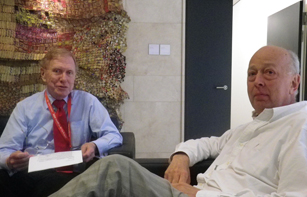
Justice Michael Kirby (left) and Professor Brian Gazzard during the expert meeting. Geneva, 02 September 2011.
World leading scientists and medical practitioners joined legal experts and civil society representatives to discuss the scientific, medical, legal and human rights aspects of the criminalization of HIV non-disclosure, exposure and transmission. The meeting, organized by UNAIDS, took place in Geneva from 31 August to 2 September.
Participants reviewed key scientific, medical, public health and legal principles that should inform the application of the criminal law to HIV. They also discussed recent developments in a number of countries where the criminalization of HIV is being reconsidered.
The meeting is part of a project to ensure that the application, if any, of criminal law to HIV exposure or transmission is appropriately circumscribed by the latest scientific evidence and legal principles in order to guarantee justice and protection of public health. The key points emanating from the expert meeting will be presented during a High Level Policy Consultation on the criminalization of HIV non-disclosure, exposure and transmission that will take place in Norway in the first quarter of 2012.
UNAIDS.org seized the opportunity to interview Professor Brian Gazzard (scientist and medical expert) and Justice Michael Kirby (a legal expert) to find out about their views on the significance, expected outcomes and potential impact of the expert meeting.
UNAIDS.org - As a scientist, what brings you to an expert meeting on the criminalization of HIV non-disclosure, exposure and transmission?
Professor Brian Gazzard (BG) - I'm not only a scientist, I'm a clinician. And I suppose as a clinician I'm interested for two reasons. One, it's become a very important agenda for most patients that I talk to. They want to know what the rules are about criminalization and the risks that it presents to them. Hopefully I've contributed to a more secure scientific knowledge about what the risks of transmission of HIV are, what the health status of somebody who's HIV infected are. I'm staggered about how little the courts still seem to know about these issues.
UNAIDS.org - What do you consider to be the role of scientists on addressing the overly broad criminalization of HIV non-disclosure, exposure and transmission?
BG - I think they have a role in pointing out what the science is. So what we're really trying to do is saying that HIV has become a manageable condition which should produce a near-normal lifespan if people have access to HIV treatment and of course, take it. This is a very different thing from the vision of the court where this is murder and the patient will die within a few months of the diagnosis and life is a disaster. Quality of life for most HIV patients, I'm pleased to say, is extremely good. And so, to actually have a situation where jurisdictions are still prosecuting people for attempted murder because HIV has been transmitted is totally unrealistic in my view.
Quality of life for most HIV patients, I'm pleased to say, is extremely good. And so, to actually have a situation where jurisdictions are still prosecuting people for attempted murder because HIV has been transmitted is totally unrealistic in my view
Professor Brian Gazzard
UNAIDS.org - In light of recent developments including evidence of the benefits of highly active antiretroviral treatment (HAART), can HIV transmission or exposure still be characterized as murder or attempted murder under the criminal law?
BG - In my view clearly not and I think any prosecutions for that would fail, but of course, even being put up for prosecution is a pretty painful process. I think it's important that prosecutorial guidelines say that this is not reasonable.
UNAIDS.org - More broadly, in your view, how should a better understanding of scientific evidence inform the criminal law in the context of HIV?
BG – Defining the intention to do harm is a complex legal issue. The probability of transmission of HIV to another person is quite low, particularly in the context of safer sex with a condom, or for people who are on HIV treatment. Whether a given individual transmits HIV or not would be a very rare and arbitrary event. So I think science is important in clarifying these facts. It isn't that the risk is so high that you have an intent when you have sex with somebody; the risk is actually very low indeed.
UNAIDS.org - In your opinion, is there any legal evidence to support the criminalization of HIV?
Justice Michael Kirby (MK) - There are some exceptional cases where the criminal law has a role to play. However, the criminal law has been pushed into a whole range of other activities which are counter-productive from the point of view of a public health response to HIV. The use of criminal law is also likely to lead to disproportionate and highly punitive measures which are not helpful in responding to the epidemic in a way that prevents the spread of HIV.
UNAIDS.org - Criminalization of HIV non-disclosure, exposure and transmission has been enforced for a number of years. Is there anything new or different in 2011?
MK - There are a number of developments which make for difference. For example, when in 2008 the original guidelines on criminalization of HIV transmission were adopted, the suggestion was not to have specific laws against HIV but to leave it to the general criminal law to deal with any egregious cases, very serious cases. We now realize that the general criminal law will often have concepts in it which are very uncertain concepts, such as criminal intention, and will also have provisions in it which are difficult to apply in the context of HIV.
Other developments have been the advances in antiretroviral treatment and, of course, a better understanding of the validity and limitations of the phylogenetic test.
So there have been technological, scientific developments, but also the realization that the 2008 guidelines didn't cover all of the issues.
UNAIDS.org - Do you think this meeting will advance efforts against the overly broad use of criminal law in the context of HIV? And if so, what needs to be done?
MK - I think the value of the group has been that it has a mixture of science and law [experts] and it has a good representation of people living with HIV. That has allowed us to look again at how and what we can do to explain the new realities of the epidemic and put forward new guidelines to help countries react appropriately regarding the criminalization of HIV.
HIV infection is not the death sentence that it was thought to be when HIV first appeared and we have to modify our policies in accordance with the developments in science and technology.
HIV infection is not the death sentence that it was thought to be when HIV first appeared and we have to modify our policies in accordance with the developments in science and technology
Justice Michael Kirby
UNAIDS.org - As a member of the UNDP-led Global Commission on HIV and the Law, how do you see this meeting contributing to the overall objective of addressing punitive laws that negatively impact the HIV response?
MK - This issue has not been a big feature of the Global Commission’s work in which I’ve been involved to date. The value of the UNAIDS driven expert meeting is that it fills an important gap. What has been discussed around our table with the inter-disciplinary people who have participated can be fed into the debates of the Global Commission and that’s exactly what I’m going to be doing.
Professor Brian Gazzard is the Clinical Research Director of the HIV Unit at the Chelsea and Westminster Hospital, one of the largest clinical units in Europe. He was also the founding Chair of the British HIV Association (BHIVA) and chaired the BHIVA Executive from 1995-2004. Brian Gazzard is also Chair of the Expert Advisory Group on AIDS (EAGA), an advisory body to the Department of Health in the United Kingdom.
Justice Michael Kirby is a retired judge of the High Court of Australia. At the time of his retirement, Justice Kirby was Australia’s longest serving judge. Since the early days of the epidemic, Justice Kirby served on many national and international bodies concerned with HIV. He currently serves as a member of the Global Commission on HIV and the Law. He is also a member of the UNAIDS Reference Group on HIV and Human Rights.
Publications
Publications
- Report on the expert meeting on the scientific, medical, legal and human rights aspects of criminalisation of HIV non-disclosure, exposure and transmission Background document
- Criminalisation of HIV Non-Disclosure, Exposure and Transmission: Scientific, Medical, Legal and Human Rights Issues
- Criminalisation of HIV Non-Disclosure, Exposure and Transmission: Background and Current Landscape
Related

Feature Story
UNAIDS Executive Director visits Finnish capital to strengthen cooperation on AIDS
06 September 2011
06 September 2011 06 September 2011
UNAIDS Executive Director Michel Sidibé meets with Finland’s Minister for International Cooperation Heidi Hautala and her delegation.
During a one day visit to Helsinki, UNAIDS Executive Director Michel Sidibé met with the Minister for International Development, the Ministry of Health, members of the Finnish Parliament, and civil society to strengthen Finland’s partnership with UNAIDS and the country’s role in the global AIDS response.
In a meeting with the newly appointed Minister for International Development, Heidi Hautala, Mr Sidibé expressed his gratitude to Finland for its longstanding involvement in the AIDS response—in particular in sub-Saharan Africa and Eastern Europe—and its support to UNAIDS.
“The Government of Finland has been a longstanding partner in the global AIDS response and has shown leadership both at home and abroad in championing evidence-based HIV programmes grounded in human rights,” said Mr Sidibé. “UNAIDS values its relationship with Finland and looks forward to strengthening our cooperation”.
Finland is a current member of the UNAIDS governing body, the Programme Coordinating Board (PCB), where it also represents Denmark and Norway. The sixth largest donor to UNAIDS, Finland has made consistent contributions to the Joint Programme and in 2010 provided more than US$ 12 million.
The Government of Finland has been a longstanding partner in the global AIDS response and has shown leadership both at home and abroad in championing evidence-based HIV programmes grounded in human rights
UNAIDS Executive Director Michel Sidibé
Mr Sidibé briefed Minister Hautala on an upcoming Forum on Millennium Development Goal 6 in Moscow from 10-12 October that will assess Eastern Europe and Central Asia’s progress on the goal focused on HIV, malaria, tuberculosis and other diseases. He encouraged Finland to participate in the Forum, stating it represents a key opportunity to work with countries in Eastern Europe to address HIV infection among key populations at higher risk.
With the Ministry of Health, Mr Sidibé commended the Permanent Secretary, Kari Välimäki, on Finland’s public health approach to HIV and its pragmatic response to the epidemic among people who inject drugs, in particular its support for harm reduction programmes. He encouraged the Ministry to consider Finland's experience in HIV control and services with governments and civil society in Eastern Europe and called attention to the dual epidemics of HIV and tuberculosis in nearby Russia and Central Asia.
The Executive Director completed his visit by participating in an interactive meeting with the All-Party Parliamentary Group on Population and Development, chaired by Parliamentarian Jani Toivola. Mr Sidibé briefed Parliamentarians and civil society representatives, including the Finnish network of people living with HIV, on the UNAIDS Strategy, the 2011 Political Declaration on HIV/AIDS, and the challenges and opportunities in the global response. The participants discussed health and HIV integration as a way to shape the broader debate on antiretroviral treatment. Mr Sidibé called on the Parliamentarians and civil society representatives to continue supporting the AIDS response and find ways to keep HIV on Finland’s development and political agendas.

